Presidency of Richard Nixon
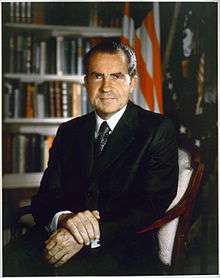
Richard Milhous Nixon was the 37th President of the United States from January 20, 1969 until he resigned on August 9, 1974, the only president to do so. Nixon took office after the passage of Lyndon Johnson's Great Society programs and did not make a major effort to repeal them, though he did advocate a "New Federalism" program that would devolve powers to state and local governments. Nixon instead concentrated on foreign affairs, and his Nixon Doctrine called for indirect assistance to American allies in the Cold War, with the "Vietnamization" of the Vietnam War being the most notable example of his doctrine. Nixon pursued a detente with the People's Republic of China, taking advantage of the Sino-Soviet split and significantly altering the nature of the Cold War. The Nixon presidency also saw the creation of the EPA, integration of Southern public schools, and the Apollo program successfully land Americans on the Moon during Nixon's presidency. Nixon's accomplishments were largely overshadowed by the scandals of the administration, and both Nixon and Vice President Spiro Agnew stepped down from office during Nixon's second term. In 1974, Nixon was succeeded by Gerald Ford, whom Nixon had chosen to succeed Agnew in 1973.
Inauguration

Nixon was inaugurated as president on January 20, 1969, sworn in by his onetime political rival, Chief Justice Earl Warren. Pat Nixon held the family Bibles open at Isaiah 2:4, which reads, "They shall beat their swords into plowshares, and their spears into pruning hooks." In his inaugural address, which received almost uniformly positive reviews, Nixon remarked that "the greatest honor history can bestow is the title of peacemaker."[1]
Foreign policy
Europe
Nixon made fifteen international trips during his presidency.[2] His first was an eight-day European visit starting in Brussels on February 23, 1969. He met with Britain’s Prime Minister Harold Wilson in London and France's President Charles de Gaulle in Paris. He also stopped in Bonn, Berlin and Rome and met with Pope Paul VI in Vatican City . He also made groundbreaking trips to several Eastern European Communist nations, including: Romania (1969), Yugoslavia (1970), and the Soviet Union (1972 and 1974).
Asia
China
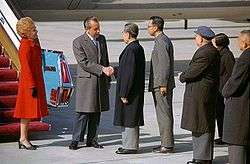
Even those who hated Nixon's presidency occasionally praise his work in China. The extent to which his visit had any profound consequences of note, however, remain very much open to debate. Nixon laid the groundwork for his overture to China even before he became president, writing in Foreign Affairs a year before his election: "There is no place on this small planet for a billion of its potentially most able people to live in angry isolation."[3] Assisting him in this venture was his National Security Advisor and future Secretary of State, Henry Kissinger, with whom the President worked closely, bypassing Cabinet officials. With relations between the Soviet Union and China at a nadir—border clashes between the two took place during Nixon's first year in office—Nixon sent private word to the Chinese through Pakistan, a country friendly to both China and United States,[4] that he desired closer relations with the Chinese. A breakthrough came in early 1971, when Chairman Mao invited a team of American table tennis players to visit China and play against top Chinese players. Nixon followed up by sending Kissinger to China for clandestine meetings with Chinese officials.[3] On July 15, 1971, it was simultaneously announced by Beijing and by Nixon (on television and radio) that the President would visit China the following February. The announcements astounded the world.[5] The secrecy allowed both sets of leaders time to prepare the political climate in their countries for the contact.[6]
In February 1972, Nixon and his wife traveled to China. Kissinger briefed Nixon for over 40 hours in preparation.[7] Upon touching down, the President and First Lady emerged from Air Force One and greeted Chinese Premier Zhou Enlai. Nixon made a point of shaking Zhou's hand, something which then-Secretary of State John Foster Dulles had refused to do in 1954 when the two met in Geneva.[8] Over 100 television journalists accompanied the president. On Nixon's orders, television was strongly favored over printed publications, as Nixon felt that the medium would capture the visit much better than print. It also gave him the opportunity to snub the print journalists he despised.[8]
Nixon and Kissinger met for an hour with Mao and Zhou at Mao's official private residence, where they discussed a range of issues.[9] Mao later told his doctor that he had been impressed by Nixon, whom he considered forthright, unlike the leftists and the Soviets.[9] He also said he was suspicious of Kissinger,[9] though the National Security Advisor referred to their meeting as his "encounter with history".[8] A formal banquet welcoming the presidential party was given that evening in the Great Hall of the People. The following day, Nixon met with Zhou; during this meeting he stated that he believed “there is one China, and Taiwan is a part of China.”[10][11][12][13] When not in meetings, Nixon toured architectural wonders including the Forbidden City, Ming Tombs, and the Great Wall.[8] Americans received their first glimpse into Chinese life through the cameras which accompanied Pat Nixon, who toured the city of Beijing and visited communes, schools, factories, and hospitals.[8]
The visit ushered in a new era of Sino-American relations.[14] Fearing the possibility of a Sino-American alliance, the Soviet Union yielded to pressure for détente with the United States.[15]
Vietnam
When Nixon took office, about 300 American soldiers were dying each week in Vietnam,[16] and the war was broadly unpopular in the United States, with widespread, sometimes violent protests against the war taking place on a regular basis (including a protest at Nixon's inauguration). The Johnson administration had agreed to suspend bombing in exchange for negotiations without preconditions, but this agreement never fully took force. According to Walter Isaacson, soon after taking office, Nixon had concluded that the Vietnam War could not be won and he was determined to end the war quickly.[17] Conversely, Black argues that Nixon sincerely believed he could intimidate North Vietnam through the Madman theory.[18] Nixon sought some arrangement which would permit American forces to withdraw, while leaving South Vietnam secure against attack.[19]
In mid-1969, Nixon began efforts to negotiate peace with the North Vietnamese, sending a personal letter to North Vietnamese leaders, and peace talks began in Paris. Initial talks, however, did not result in an agreement.[20] In July 1969, Nixon visited South Vietnam, where he met with his U.S. military commanders and President Nguyen Van Thieu. Amid protests at home demanding an immediate pullout, he implemented a strategy of replacing American troops with Vietnamese troops, known as "Vietnamization".[14] He soon instituted phased U.S. troop withdrawals[21] but authorized incursions into Laos, in part to interrupt the Ho Chi Minh trail, used to supply North Vietnamese forces, that passed through Laos and Cambodia. Nixon announced the ground invasion of Cambodia to the American public on April 30, 1970.[22] His responses to protesters included an impromptu, early morning meeting with them at the Lincoln Memorial on May 9, 1970.[23][24][25] Documents uncovered from the Soviet archives after 1991 reveal that the North Vietnamese attempt to overrun Cambodia in 1970 was launched at the explicit request of the Khmer Rouge and negotiated by Pol Pot's then second in command, Nuon Chea.[26] Nixon's campaign promise to curb the war, contrasted with the escalated bombing, led to claims that Nixon had a "credibility gap" on the issue.[21]
In 1971, excerpts from the "Pentagon Papers", which had been leaked by Daniel Ellsberg, were published by The New York Times and The Washington Post. When news of the leak first appeared, Nixon was inclined to do nothing; the Papers, a history of United States' involvement in Vietnam, mostly concerned the lies of prior administrations and contained few real revelations. He was persuaded by Kissinger that the papers were more harmful than they appeared, and the President tried to prevent publication. The Supreme Court eventually ruled for the newspapers.[27]
As U.S. troop withdrawals continued, conscription was reduced and in 1973 ended; the armed forces became all-volunteer.[28] After years of fighting, the Paris Peace Accords were signed at the beginning of 1973. The agreement implemented a cease fire and allowed for the withdrawal of remaining American troops; however, it did not require the 160,000 North Vietnam Army regulars located in the South to withdraw.[29] Once American combat support ended, there was a brief truce, before fighting broke out again, this time without American combat involvement. North Vietnam conquered South Vietnam in 1975.[30] Communist governments also took power in Laos and Cambodia.
Latin America

Cuba
Nixon had been a firm supporter of Kennedy in the 1961 Bay of Pigs Invasion and 1962 Cuban Missile Crisis; on taking office he stepped up covert operations against Cuba and its president, Fidel Castro. He maintained close relations with the Cuban-American exile community through his friend, Bebe Rebozo, who often suggested ways of irritating Castro. These activities concerned the Soviets and Cubans, who feared Nixon might attack Cuba in violation of the understanding between Kennedy and Khrushchev which had ended the missile crisis. In August 1970, the Soviets asked Nixon to reaffirm the agreement. Despite his hard line against Castro, Nixon agreed. The process—which began in secret, but quickly leaked—had not been completed when the U.S. deduced that the Soviets were expanding their base at the Cuban port of Cienfuegos in October 1970. A minor confrontation ensued, which was concluded with an understanding that the Soviets would not use Cienfuegos for submarines bearing ballistic missiles. The final round of diplomatic notes, reaffirming the 1962 accord, were exchanged in November.[31]
Chile
The election of Marxist candidate Salvador Allende as President of Chile in September 1970 led Nixon to order that Allende not be allowed to take office.[32]:25 Nixon pursued a vigorous campaign of covert resistance to Allende, first designed to convince the Chilean congress to confirm Jorge Alessandri as the winner of the election. When this failed, false flag operatives approached senior Chilean military officers, in "some two dozen contacts", with the message that "the U.S. desired....a coup."[32] The CIA also provided "$50,000 cash, three submachine guns, and a satchel of tear gas", for a plan to kidnap Chilean general René Schneider, although Schneider was assassinated by Roberto Viaux (a right-wing extremist who the CIA had discouraged from staging a coup) before this could be attempted.[33][34][35]
Once Allende took office, extensive covert efforts continued with US-funded black propaganda placed in El Mercurio, strikes organized against Allende, and funding for Allende opponents. When El Mercurio requested significant funds for covert support in September 1971, “...in a rare example of presidential micromanagement of a covert operation, Nixon personally authorized the $700,000—and more if necessary—in covert funds to El Mercurio.[32]:93 The Chilean Chamber of Deputies accused Allende of providing support to armed groups, torture, illegal arrests, muzzling the press, confiscating private property, and not allowing people to leave the country.[36] General Augusto Pinochet overthrew Allende in a violent coup d'état on September 11, 1973, after being refused direct American aid.[37][38]
Soviet Union
Nixon used the improving international environment to address the topic of nuclear peace. Following the announcement of his visit to China, the Nixon administration concluded negotiations for him to visit the Soviet Union. The President and First Lady arrived in Moscow on May 22, 1972 and met with Leonid Brezhnev, the General Secretary of the Communist Party; Alexei Kosygin, the Chairman of the Council of Ministers; and Nikolai Podgorny, the head of state, among other leading Soviet officials.[39]
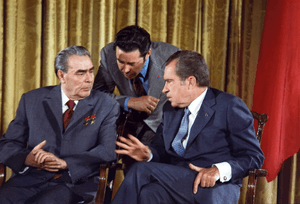
Nixon engaged in intense negotiations with Brezhnev.[39] Out of the summit came agreements for increased trade and two landmark arms control treaties: SALT I, the first comprehensive limitation pact signed by the two superpowers,[14] and the Anti-Ballistic Missile Treaty, which banned the development of systems designed to intercept incoming missiles. Nixon and Brezhnev proclaimed a new era of "peaceful coexistence". A banquet was held that evening at the Kremlin.[39]
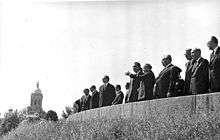
Seeking to foster better relations with the United States, both China and the Soviet Union cut back on their diplomatic support for North Vietnam and advised Hanoi to come to terms militarily.[40][41][42] Nixon later described his strategy:
I had long believed that an indispensable element of any successful peace initiative in Vietnam was to enlist, if possible, the help of the Soviets and the Chinese. Though rapprochement with China and détente with the Soviet Union were ends in themselves, I also considered them possible means to hasten the end of the war. At worst, Hanoi was bound to feel less confident if Washington was dealing with Moscow and Beijing. At best, if the two major Communist powers decided that they had bigger fish to fry, Hanoi would be pressured into negotiating a settlement we could accept.[43]
Having made considerable progress over the previous two years in US-Soviet relations, Nixon embarked on a second trip to the Soviet Union in 1974.[44] He arrived in Moscow on June 27 to a welcome ceremony, cheering crowds, and a state dinner at the Grand Kremlin Palace that evening.[44] Nixon and Brezhnev met in Yalta, where they discussed a proposed mutual defense pact, détente, and MIRVs. While he considered proposing a comprehensive test-ban treaty, Nixon felt he would not have time as president to complete it.[44] There were no significant breakthroughs in these negotiations.[44]
Middle East
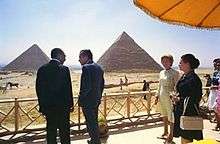
As part of the Nixon Doctrine that the U.S. would avoid direct combat assistance to allies where possible, instead giving them assistance to defend themselves, the U.S. greatly increased arms sales to the Middle East—particularly Israel, Iran and Saudi Arabia—during the Nixon administration.[45] The Nixon administration strongly supported Israel, an American ally in the Middle East but the support was not unconditional. Nixon believed that Israel should make peace with its Arab neighbors and that the United States should encourage it. The president believed that—except during the Suez Crisis—the U.S. had failed to intervene with Israel, and should use the leverage of the large U.S. military aid to Israel to urge the parties to the negotiating table. However, the Arab-Israeli conflict was not a major focus of Nixon's attention during his first term—for one thing, he felt that no matter what he did, American Jews would oppose his reelection.
When an Arab coalition led by Egypt and Syria attacked in October 1973, beginning the Yom Kippur War, Israel suffered initial losses. The U.S. took no action for several days, until Nixon ordered an airlift to Israel, taking personal responsibility for any response by Arab nations. Nixon cut through inter-departmental squabbles and bureaucracy to initiate an airlift of American arms. By the time the U.S. and Soviet Union negotiated a truce, Israel had penetrated deep into enemy territory. A long-term effect was the movement of Egypt away from the Soviets toward the U.S. But Israel's victory came at the cost to the U.S. of the 1973 oil crisis; the members of OPEC decided to raise oil prices in response to the American support of Israel.[46] After Nixon chose to go off the gold standard, foreign countries increased their currency reserves in anticipation of currency fluctuation, which caused deflation of the dollar and other world currencies. Since oil was paid for in dollars, OPEC was receiving less value for their product. They cut production and announced price hikes as well as an embargo targeted against the United States and the Netherlands, specifically blaming U.S. support for Israel in the Yom Kippur War for the actions.[47] The embargo caused gasoline shortages and rationing in the United States in late 1973, and was eventually ended by the oil-producing nations as peace took hold.[48] Kissinger played a major role in the settlement, and was also able to reestablish U.S. relations with Egypt for the first time since 1967; Nixon made one of his final international visits as president there in June 1974.[49]
List of international trips
Nixon made fifteen international trips to 42 different countries during his presidency.[50]
| Dates | Country | Locations | Details | |
|---|---|---|---|---|
| 1 | February 23–24, 1969 | Brussels | Attended the 23rd meeting of North Atlantic Council. Met with King Baudouin I. | |
| February 24–26, 1969 | London | Informal visit. Delivered several public addresses. | ||
| February 26–27, 1969 | West Berlin Bonn |
Delivered several public addresses. Addressed the Bundestag. | ||
| February 27–28, 1969 | Rome | Met with President Giuseppe Saragat and Prime Minister Mariano Rumor and other officials. | ||
| February 28 – March 2, 1969 |
Paris | Met with President Charles de Gaulle. | ||
| March 2, 1969 | Apostolic Palace | Audience with Pope Paul VI. | ||
| 2 | July 26–27, 1969 | Manila | State visit. Met with President Ferdinand Marcos. | |
| July 27–28, 1969 | Jakarta | State visit. Met with President Suharto. | ||
| July 28–30, 1969 | Bangkok | State visit. Met with King Bhumibol Adulyadej. | ||
| July 30, 1969 | Saigon, Di An |
Met with President Nguyen Van Thieu. Visited U.S. military personnel. | ||
| July 31 – August 1, 1969 | New Delhi | State visit. Met with Acting President Mohammad Hidayatullah. | ||
| August 1–2, 1969 | Lahore | State visit. Met with President Yahya Khan. | ||
| August 2–3, 1969 | Bucharest | Official visit. Met with President Nicolae Ceaușescu. | ||
| August 3, 1969 | RAF Mildenhall | Informal meeting with Prime Minister Harold Wilson. | ||
| 3 | September 8, 1969 | Ciudad Acuña | Dedication of Amistad Dam with President Gustavo Díaz Ordaz. | |
| 4 | August 20–21, 1970 | Puerto Vallarta | Official visit. Met with President Gustavo Díaz Ordaz. | |
| 5 | September 27–30, 1970 | Rome, Naples |
Official visit. Met with President Giuseppe Saragat. Visited NATO Southern Command. | |
| September 28, 1970 | Apostolic Palace | Audience with Pope Paul VI. | ||
| September 30 – October 2, 1970 |
Belgrade, Zagreb |
State visit. Met with President Josip Broz Tito. | ||
| October 2–3, 1970 | Madrid | State visit. Met with Generalissimo Francisco Franco. | ||
| October 3, 1970 | Chequers | Met informally with Queen Elizabeth II and Prime Minister Edward Heath. | ||
| October 3–5, 1970 | Limerick, Timahoe, Dublin |
State visit. Met with T Prime Minister Jack Lynch. | ||
| 6 | November 12, 1970 | Paris | Attended the memorial services for former President Charles de Gaulle. | |
| 7 | December 13–14, 1971 | Terceira Island | Discussed international monetary problems with French President Georges Pompidou and Portuguese Prime Minister Marcelo Caetano. | |
| 8 | December 20–21, 1971 | Hamilton | Met with Prime Minister Edward Heath. | |
| 9 | February 21–28, 1972 | Shanghai, Peking, Hangchow |
State visit. Met with Party Chairman Mao Zedong and Premier Zhou Enlai. | |
| 10 | April 13–15, 1972 | Ottawa | State visit. Met with Governor General Roland Michener and Prime Minister Pierre Trudeau. Addressed Parliament. Signed the Great Lakes Water Quality Agreement.[51] | |
| 11 | May 20–22, 1972 | Salzburg | Informal visit. Met with Chancellor Bruno Kreisky. | |
| May 22–30, 1972 | Moscow, Leningrad, Kiev |
State visit. Met with Premier Alexei Kosygin and General Secretary Leonid Brezhnev. Signed the SALT I and ABM Treaties. | ||
| May 30–31, 1972 | Tehran | Official visit. Met with Shah Mohammad Reza Pahlavi. | ||
| May 31 – June 1, 1972 | Warsaw | Official visit. Met with First Secretary Edward Gierek. | ||
| 12 | May 31 – June 1, 1973 | Reykjavík | Met with President Kristján Eldjárn and Prime Minister Ólafur Jóhannesson and French President Georges Pompidou. | |
| 13 | April 5–7, 1974 | Paris | Attended the memorial services for former President Georges Pompidou. Met afterward with interim President Alain Poher, Italian President Giovanni Leone, British Prime Minister Harold Wilson, West German Chancellor Willy Brandt, Danish Prime Minister Poul Hartling, Soviet President Nikolai Podgorny and Japanese Prime Minister Kakuei Tanaka. | |
| 14 | June 10–12, 1974 | Salzburg | Met with Chancellor Bruno Kreisky. | |
| June 12–14, 1974 | Cairo, Alexandria |
Met with President Anwar Sadat. | ||
| June 14–15, 1974 | Jedda | Met with King Faisal. | ||
| June 15–16, 1974 | Damascus | Met with President Hafez al-Assad. | ||
| June 16–17, 1974 | Tel Aviv, Jerusalem |
Met with President Ephraim Katzir and Prime Minister Yitzhak Rabin. | ||
| June 17–18, 1974 | Amman | State visit. Met with King Hussein. | ||
| June 18–19, 1974 | Lajes Field | Met with President António de Spínola. | ||
| 15 | June 25–26, 1974 | Brussels | Attended the North Atlantic Council Meeting. Met separately with King Baudouin I and Queen Fabiola, Prime Minister Leo Tindemans, and with German Chancellor Helmut Schmidt, British Prime Minister Harold Wilson and Italian Prime Minister Mariano Rumor. | |
| June 27 – July 3, 1974 | Moscow, Minsk, Oreanda |
Official visit. Met with General Secretary Leonid Brezhnev, President Nikolai Podgorny and Premier Alexei Kosygin. Signing of the Threshold Test Ban Treaty. |
Domestic policy
Economy
At the time Nixon took office in 1969, inflation was at 4.7 percent—its highest rate since the Korean War. The Great Society had been enacted under Johnson, which, together with the Vietnam War costs, was causing large budget deficits. There was little unemployment, but interest rates were at their highest in a century.[52] Nixon's major economic goal was to reduce inflation; the most obvious means of doing so was to end the war.[52] This could not be accomplished overnight, and the U.S. economy continued to struggle through 1970, contributing to a lackluster Republican performance in the midterm congressional elections (Democrats controlled both Houses of Congress throughout Nixon's presidency).[53] According to political economist Nigel Bowles in his 2011 study of Nixon's economic policies, the new president did little to alter Johnson's policies through the first year of his presidency.[54]
Nixon was far more interested in foreign affairs than domestic policies, but believed that voters tend to focus on their own financial condition, and that economic conditions were a threat to his reelection. As part of his "New Federalism" views, he proposed grants to the states, but these proposals were for the most part lost in the congressional budget process. However, Nixon gained political credit for advocating them.[53] In 1970, Congress had granted the President the power to impose wage and price freezes, though the Democratic majorities, knowing Nixon had opposed such controls through his career, did not expect Nixon to actually use the authority.[54] With inflation unresolved by August 1971, and an election year looming, Nixon convened a summit of his economic advisers at Camp David. He then announced temporary wage and price controls, allowed the dollar to float against other currencies, and ended the convertibility of the dollar into gold.[55] Bowles points out, "by identifying himself with a policy whose purpose was inflation's defeat, Nixon made it difficult for Democratic opponents ... to criticize him. His opponents could offer no alternative policy that was either plausible or believable since the one they favored was one they had designed but which the president had appropriated for himself."[54] Nixon's policies dampened inflation through 1972, although their aftereffects contributed to inflation during his second term and into the Ford administration.[55]
After he won reelection, Nixon found inflation was increasing, and the legislation authorizing price controls expired April 30, 1973. The Senate Democratic Caucus recommended a 90-day freeze on all profits, interest rates, and prices.[56] Nixon re-imposed price controls in June 1973, echoing his 1971 plan, as food prices rose; this time, he focused on agricultural exports and limited the freeze to 60 days.[56] The price controls became unpopular with the public and businesspeople, who saw powerful labor unions as preferable to the price board bureaucracy. [56] Business owners, however, now saw the controls as permanent rather than temporary, and voluntary compliance among small businesses decreased. [56] The controls produced food shortages, as meat disappeared from grocery stores and farmers drowned chickens rather than sell them at a loss.[56] Despite the failure to control inflation, controls were slowly ended, and on April 30, 1974, their statutory authorization lapsed.[56] Nixon also dramatically increased spending on federal employees' salaries while the economy was plagued by the 1973–1974 stock market crash.[57]
Governmental initiatives and organization
Nixon advocated a "New Federalism", which would devolve power to state and local elected officials, though Congress was hostile to these ideas and enacted few of them.[58] Nixon hoped to reduce the number of government departments to eight: The existing departments of State, Justice, Treasury, and Defense, with the remainder of the Executive Branch made parts of new departments of Economic Affairs, Natural Resources, Human Resources, and Community Development. Although Nixon did not succeed in this,[59] he did eliminate one Cabinet-level department, the United States Post Office Department, which in 1971 became the government-run United States Postal Service.[60]
Nixon was a late convert to the conservation movement. Environmental policy had not been a significant issue in the 1968 election; the candidates were rarely asked for their views on the subject. He saw that the first Earth Day in April 1970 presaged a wave of voter interest on the subject, and sought to use that to his benefit; in June he announced the formation of the Environmental Protection Agency (EPA). Nixon broke new ground by discussing environment policy in his State of the Union speech; other initiatives supported by Nixon included the Clean Air Act of 1970 and Occupational Safety and Health Administration (OSHA); the National Environmental Policy Act required environmental impact statements for many Federal projects.[61] Nixon vetoed the Clean Water Act of 1972—objecting not to the policy goals of the legislation but to the amount of money to be spent on them, which he deemed excessive. After Congress overrode his veto, Nixon impounded the funds he deemed unjustifiable.[62]
In August 1970, Sen. Ted Kennedy (D-MA) introduced a bipartisan bill for universal national health insurance.[63][lower-alpha 1] In February 1971, Nixon proposed more limited health insurance reform—a private health insurance[lower-alpha 2] employer mandate,[lower-alpha 3] federalization of Medicaid[lower-alpha 4] for poor families with dependent minor children,[64] and support for health maintenance organizations (HMOs).[65] House and Senate hearings on national health insurance were held in 1971, but no bill had the support of House Ways and Means and Senate Finance committee chairmen Rep. Wilbur Mills (D-AR) and Sen. Russell Long (D-LA).[64] A limited HMO bill was enacted in December 1973.[65]
In October 1973, Sen. Long and Sen. Abraham Ribicoff (D-CT) introduced a bipartisan bill for catastrophic health insurance coverage for workers[lower-alpha 5] and federalization of Medicaid[lower-alpha 4] with extension to the poor without dependent minor children.[66] In February 1974, Nixon proposed more comprehensive health insurance reform—a private health insurance[lower-alpha 2] employer mandate[lower-alpha 3] and replacement of Medicaid[lower-alpha 4] by state-run health insurance plans available to all, with income-based premiums and cost sharing.[67] In April 1974, Sen. Kennedy and Rep. Mills introduced a bill for near-universal national health insurance with benefits identical to the expanded Nixon plan.[67][lower-alpha 6][lower-alpha 7] In August 1974, after Nixon's resignation and President Ford's call for health insurance reform, Rep. Mills tried to advance a compromise based on Nixon's plan,[lower-alpha 8] but gave up when the conservative half of his committee instead backed the AMA's limited "Medicredit" voluntary tax credit plan.[67][68]
As one policy initiative, Pres. Nixon called for more money for sickle cell research, treatment, and education in February 1971[69] and signed the National Sickle Cell Anemia Control Act on May 16, 1972.[70][71][lower-alpha 9] However, one writer on sickle cell states that while Nixon called for increased spending on such high-profile items as cancer and sickle cell, at the same time he sought to reduce overall spending at NIH (National Institutes of Health) as part of his general conservative approach to government.[72]
Faced with a generally liberal Democratic Congress during his presidency,[73] Nixon used his power over executive agencies to obstruct the authorization of programs that he was opposed to. As noted by one observer,
"He (Nixon) claimed the authority to “impound,” or withhold, money Congress appropriated to support them."[73]
U.S. space program

After a nearly decade-long national effort, the United States won the race to land astronauts on the moon on July 20, 1969, with the flight of Apollo 11. Nixon spoke with Neil Armstrong and Buzz Aldrin during their moonwalk. He called the conversation "the most historic phone call ever made from the White House".[74] Nixon, however, was unwilling to keep funding for the National Aeronautics and Space Administration (NASA) at the high level seen through the 1960s as NASA prepared to send men to the moon. NASA Administrator Thomas O. Paine drew up ambitious plans for the establishment of a permanent base on the moon by the end of the 1970s and the launch of a manned expedition to Mars as early as 1981. Nixon, however, rejected both proposals.[75]
On May 24, 1972, Nixon approved a five-year cooperative program between NASA and the Soviet space program, culminating in the Apollo–Soyuz Test Project, a joint mission of an American Apollo and a Soviet Soyuz spacecraft in 1975.[76]
Civil rights
The Nixon years witnessed the first large-scale integration of public schools in the South.[77] Nixon sought a middle way between the segregationist Wallace and liberal Democrats, whose support of integration was alienating some Southern whites.[78] Hopeful of doing well in the South in 1972, he sought to dispose of desegregation as a political issue before then. Soon after his inauguration, he appointed Vice President Agnew to lead a task force, which worked with local leaders—both white and black—to determine how to integrate local schools. Agnew had little interest in the work, and most of it was done by Labor Secretary George Shultz. Federal aid was available, and a meeting with President Nixon was a possible reward for compliant committees. By September 1970, less than ten percent of black children were attending segregated schools. By 1971, however, tensions over desegregation surfaced in Northern cities, with angry protests over the busing of children to schools outside their neighborhood to achieve racial balance. Nixon opposed busing personally but enforced court orders requiring its use.[79]
In addition to desegregating public schools, Nixon implemented the Philadelphia Plan in 1970—the first significant federal affirmative action program.[80] He also endorsed the Equal Rights Amendment after it passed both houses of Congress in 1972 and went to the states for ratification.[81] Nixon had campaigned as an ERA supporter in 1968, though feminists criticized him for doing little to help the ERA or their cause after his election. Nevertheless, he appointed more women to administration positions than Lyndon Johnson had.[82]
Reelection
Nixon believed his rise to power had peaked at a moment of political realignment. The Democratic "Solid South" had long been a frustration to Republican ambitions. Goldwater had won several Southern states by opposing the Civil Rights Act of 1964 but had alienated more moderate Southerners. Nixon's efforts to gain Southern support in 1968 were diluted by Wallace's candidacy. Through his first term, he pursued a Southern Strategy with policies, such as his desegregation plans, that would be broadly acceptable among Southern whites, encouraging them to realign with the Republicans in the aftermath of the Civil Rights era. He nominated two Southern conservatives, Clement Haynsworth and G. Harrold Carswell to the Supreme Court, but neither was confirmed by the Senate.[83]
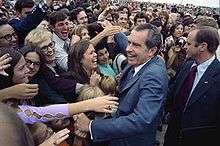
Nixon entered his name on the New Hampshire primary ballot on January 5, 1972, effectively announcing his candidacy for reelection.[84] Virtually assured the Republican nomination,[85] the President had initially expected his Democratic opponent to be Massachusetts Senator Ted Kennedy (brother of the late president), but he was largely removed from contention after the 1969 Chappaquiddick incident.[86] Instead, Maine Senator Edmund Muskie became the front runner, with South Dakota Senator George McGovern in a close second place.[84]

On June 10, McGovern won the California primary and secured the Democratic nomination.[87] The following month, Nixon was renominated at the 1972 Republican National Convention. He dismissed the Democratic platform as cowardly and divisive.[88] McGovern intended to sharply reduce defense spending[89] and supported amnesty for draft evaders as well as abortion rights. With some of his supporters believed to be in favor of drug legalization, McGovern was perceived as standing for "amnesty, abortion and acid". McGovern was also damaged by his vacillating support for his original running mate, Missouri Senator Thomas Eagleton, dumped from the ticket following revelations that he had received treatment for depression.[90][91] Nixon was ahead in most polls for the entire election cycle, and was reelected on November 7, 1972 in one of the largest landslide election victories in American history. He defeated McGovern with over 60 percent of the popular vote, losing only in Massachusetts and the District of Columbia.[92]
Second term (1973–74) and resignation
Watergate
| Watergate scandal |
|---|
| Events |
| People |
|
Watergate burglars |
|
Judiciary |
|
Intelligence community |
The term Watergate has come to encompass an array of clandestine and often illegal activities undertaken by members of the Nixon administration. Those activities included "dirty tricks" such as bugging the offices of political opponents and people of whom Nixon or his officials were suspicious. Nixon and his close aides ordered harassment of activist groups and political figures, using the FBI, CIA, and the IRS. The activities became known after five men were caught breaking into Democratic party headquarters at the Watergate complex in Washington, D.C. on June 17, 1972. The Washington Post picked up on the story; reporters Carl Bernstein and Bob Woodward relied on an informant known as "Deep Throat"—later revealed to be Mark Felt, associate director at the FBI—to link the men to the Nixon administration. Nixon downplayed the scandal as mere politics, calling news articles biased and misleading. As a series of revelations made it clear that Nixon aides had committed crimes in attempts to sabotage the Democrats and others, senior aides such as White House Counsel John Dean and Chief of Staff H. R. Haldeman faced prosecution.[14][93][94]
In July 1973, White House aide Alexander Butterfield testified that Nixon had a secret taping system that recorded his conversations and phone calls in the Oval Office. These tapes were subpoenaed by Watergate Special Counsel Archibald Cox. Nixon refused to release them, citing executive privilege. With the White House and Cox at loggerheads, Nixon had Cox fired in October in the "Saturday Night Massacre"; he was replaced by Leon Jaworski. In November, Nixon's lawyers revealed that an audio tape of conversations, held in the White House on June 20, 1972, featured an 18½ minute gap.[94] Rose Mary Woods, the President's personal secretary, claimed responsibility for the gap, alleging that she had accidentally wiped the section while transcribing the tape, though her tale was widely mocked. The gap, while not conclusive proof of wrongdoing by the President, cast doubt on Nixon's statement that he had been unaware of the cover-up.[95]
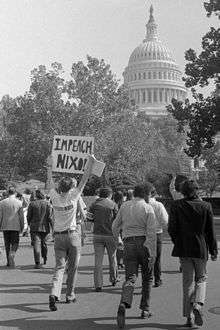
Though Nixon lost much popular support, even from his own party, he rejected accusations of wrongdoing and vowed to stay in office.[94] He insisted that he had made mistakes, but had no prior knowledge of the burglary, did not break any laws, and did not learn of the cover-up until early 1973.[96] On October 10, 1973, Vice President Agnew resigned amid allegations—unrelated to Watergate—of bribery, tax evasion and money laundering from his tenure as Maryland's governor. Nixon chose Gerald Ford, Minority Leader of the House of Representatives, to replace Agnew.[97]
On November 17, 1973, during a televised question and answer session with the press,[98] Nixon said,
People have got to know whether or not their President is a crook. Well, I'm not a crook. I've earned everything I've got.[99]
The legal battle over the tapes continued through early 1974, and in April 1974 Nixon announced the release of 1,200 pages of transcripts of White House conversations between him and his aides. The House Judiciary Committee, opened impeachment hearings against the President on May 9, 1974, which were televised on the major networks. These hearings culminated in votes for articles of impeachment, the first being 27–11 in favor on July 27, 1974 on obstruction of justice.[96] On July 24, the Supreme Court ruled unanimously that the full tapes, not just selected transcripts must be released.[100]
Even with support diminished by the continuing series of revelations, Nixon hoped to win through. However, one of the newly released tapes, the "Smoking Gun Tape", recorded soon after the break-in, demonstrated that Nixon had been told of the White House connection to the Watergate burglaries soon after they took place, and had approved plans to thwart the investigation. In a statement accompanying the release of the tapes on August 5, 1974, Nixon accepted blame for misleading the country about when he had been told of the truth behind the Watergate break-in, stating that he had a lapse of memory.[101] With their release, the bottom fell out of Nixon's political support. He met with Republican congressional leaders soon after, and was told he faced certain impeachment in the House and had, at most, 18 senators who might vote against his conviction on the articles of impeachment—far fewer than the 34 he needed to avoid removal from office.[102][103]
Nixon resigns
 |
Richard Nixon resigns
Resignation speech of President Richard Nixon, delivered August 8, 1974. |
| Problems playing this file? See media help. | |
In the light of his loss of political support and the near certainty of impeachment and removal from office, Nixon resigned the presidency on August 9, 1974, after addressing the nation on television the previous evening.[96] The resignation speech was delivered from the Oval Office and was carried live on radio and television. Nixon stated that he was resigning for the good of the country and asked the nation to support the new president, Gerald Ford. Nixon went on to review the accomplishments of his presidency, especially in foreign policy.[104] He defended his record as president, and stated:
Sometimes I have succeeded and sometimes I have failed, but always I have taken heart from what Theodore Roosevelt once said about the man in the arena, "whose face is marred by dust and sweat and blood, who strives valiantly, who errs and comes up short again and again because there is not effort without error and shortcoming, but who does actually strive to do the deed, who knows the great enthusiasms, the great devotions, who spends himself in a worthy cause, who at the best knows in the end the triumphs of high achievements and who at the worst, if he fails, at least fails while daring greatly".[105]
Nixon's speech contained no admission of wrongdoing, and was termed "a masterpiece" by Conrad Black, one of his biographers. Black opined that "What was intended to be an unprecedented humiliation for any American president, Nixon converted into a virtual parliamentary acknowledgement of almost blameless insufficiency of legislative support to continue. He left while devoting half his address to a recitation of his accomplishments in office."[106] The initial response from network commentators was generally favorable, with only Roger Mudd of CBS stating that Nixon had evaded the issue, and had not admitted his role in the cover-up.[107]
This was the ninth time in U.S. history that an incumbent President did not complete a term that he had been elected to; it was, however, the first to occur for a reason other than death. To date, Nixon is the only president to have resigned.
Administration and Cabinet
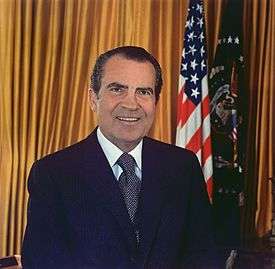
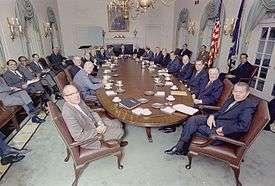
Judicial appointments
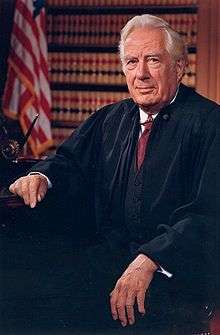
Supreme Court
- Warren E. Burger – 1969 as Chief Justice
- Harry Blackmun – 1970
- Lewis F. Powell, Jr. – 1971
- William Rehnquist – 1971
Other court appointments
Nixon appointed 231 federal judges, surpassing the previous record of 193 set by Franklin D. Roosevelt. Among these were four Justices to the Supreme Court of the United States (including one Chief Justice), 46 judges to the United States Courts of Appeals, and 181 judges to the United States district courts.
Notes
- ↑ with no cost sharing
- 1 2 with substantial cost sharing
- 1 2 voluntary for employees
- 1 2 3 for Medicaid acute care; no change to Medicaid long-term care for elderly or disabled
- ↑ financed by a payroll tax
- ↑ but with one-third lower cost sharing and financing by payroll and other taxes
- ↑ Kennedy-Mills was criticized by organized labor and senior citizen groups because of its substantial cost sharing
- ↑ but mandatory for employees, with lower cost sharing, and catastrophic coverage for workers financed by a payroll tax
- ↑ see especially page 2 (after introductory material) in which a bar graph displays NHLBI funding for sickle cell research from FY 1972 through FY 2001, totaling $923 million for these thirty years, starting at $10 million for 1972, then about $15 million a year through 1976, about $20 million for 1977, etc
Citations
- ↑ Black, pp. 567–68.
- ↑ "Travels of President Richard M. Nixon". U.S. Department of State Office of the Historian.
- 1 2 Miller Center.
- ↑ http://www.u-s-history.com/pages/h1877.html
- ↑ Ambrose 1989, p. 453.
- ↑ Goh-Small.
- ↑ Black, p. 778.
- 1 2 3 4 5 PBS, The Nixon Visit.
- 1 2 3 Black, pp. 780–782.
- ↑ Kaufman, Victor S. (2001), pp. 228–231
- ↑ Kubek, Anthony (1992). "The 'Opening' of China: President Nixon's 1972 Journey". American Asian Review. 10 (4): 1–22. ISSN 0737-6650.
- ↑ Tucker, Nancy Bernkopf (2005). "Taiwan Expendable? Nixon and Kissinger Go to China". Journal of American History. 92 (1): 109–135. doi:10.2307/3660527. ISSN 0021-8723. JSTOR 3660527.
- ↑ Ambrose 1989, p. 516.
- 1 2 3 4 Nixon Library, President.
- ↑ Dallek, p. 300.
- ↑ "Vietnam War Deaths and Casualties By Month". The American War Library. Retrieved June 22, 2012.
- ↑ Drew, p. 65.
- ↑ Black, p. 572, 1055: "Nixon, so often a pessimist, thought he could end the Vietnam war within a year....He somehow imagined he could partly replicate Eisenhower's peace in Korea.".
- ↑ Black, p. 569.
- ↑ Ambrose 1989, pp. 281–283.
- 1 2 Time 1971-04-05.
- ↑ AP/St. Peterburg Independent.
- ↑ Safire pp205–209.
- ↑ UPI/Beaver County Times 1970-05-09.
- ↑ Black, pp. 675–676.
- ↑ Dmitry Mosyakov, "The Khmer Rouge and the Vietnamese Communists: A History of Their Relations as Told in the Soviet Archives," in Susan E. Cook, ed., Genocide in Cambodia and Rwanda (Yale Genocide Studies Program Monograph Series No. 1, 2004), p54ff. Available at: www.yale.edu/gsp/publications/Mosyakov.doc "In April–May 1970, many North Vietnamese forces entered Cambodia in response to the call for help addressed to Vietnam not by Pol Pot, but by his deputy Nuon Chea. Nguyen Co Thach recalls: "Nuon Chea has asked for help and we have liberated five provinces of Cambodia in ten days."
- ↑ Ambrose 1989, pp. 446–448.
- ↑ Evans.
- ↑ Ambrose 1991, pp. 53–55.
- ↑ Ambrose 1991, p. 473.
- ↑ Ambrose 1989, pp. 379–383.
- 1 2 3 Kornbluh, Peter (2003). The Pinochet File: A Declassified Dossier on Atrocity and Accountability. New York: The New Press. ISBN 1-56584-936-1.
- ↑ Weiner, Tim (2007). Legacy of Ashes: The History of the CIA. New York: Anchor Books. p. 361. ISBN 978-0-307-38900-8.
- ↑ Alleged Assassination Plots Involving Foreign Leaders (1975), Church Committee, pages 246–247 and 250–254.
- ↑ Falcoff, Mark, Kissinger and Chile, Commentary, 2003.
- ↑ "Declaration on the Breakdown of Chile's Democracy," Resolution of the Chamber of Deputies, Chile, August 22, 1973.
- ↑ Black, pp. 920–921.
- ↑ CIA (19 September 2000). "CIA Activities in Chile". Chile Documentation Project. National Security Archive. p. 13.
- 1 2 3 BBC 1972-05-22.
- ↑ Gaddis, pp. 294, 299.
- ↑ Guan, pp. 61, 69, 77–79.
- ↑ Zhai, p. 136.
- ↑ Nixon 1985, pp. 105–106.
- 1 2 3 4 Black, p. 963.
- ↑ Hanhimäki-Small.
- ↑ Original URL, archived on July 12, 2008, "Second Arab Oil Embargo, 1973–1974". U.S. Department of State. Retrieved on July 17, 2011.
- ↑ Black, pp. 923–928.
- ↑ Ambrose 1991, p. 311.
- ↑ Black, pp. 951–52, 959.
- ↑ "Travels of President Richard M. Nixon". U.S. Department of State Office of the Historian.
- ↑ National Research Council (U.S.); Royal Society of Canada (1985). The Great Lakes Water Quality Agreement: an evolving instrument for ecosystem management. Washington, D.C.: National Academy Press. p. 22.
- 1 2 Ambrose 1989, pp. 225–226.
- 1 2 Ambrose 1989, pp. 431–432.
- 1 2 3 Bowles-Small.
- 1 2 Aitken, pp. 399–400.
- 1 2 3 4 5 6 Hetzel, p. 92.
- ↑ Nixon, Richard (December 15, 1972). "428 – Message to the Congress on Federal Civilian and Military Pay Increases". American Presidency Project. Retrieved November 5, 2008.
- ↑ Aitken, p. 395.
- ↑ Black, p. 846.
- ↑ USPS, Periodicals postage.
- ↑ Aitken, pp. 397–398.
- ↑ Aitken, p. 396.
- ↑ NHI: CQ Almanac 1970.
- 1 2 NHI: CQ Almanac 1971.
- 1 2 HMO: CQ Almanac 1973.
- ↑ NHI: CQ Almanac 1973.
- 1 2 3 NHI: CQ Almanac 1974.
- ↑ Wainess 1999.
- ↑ Office of the Federal Register, pp. 179–182.
- ↑ The American Presidency Project.
- ↑ National Heart, Lung, and Blood Institute, p. 2.
- ↑ Wailoo, pp. 165 & 170.
- 1 2 https://books.google.com/books?id=VitlO1mWxzAC&pg=RA1-PA1972
- ↑ Parmet, p. 563.
- ↑ Handlin.
- ↑ NASA, The Partnership, ch. 6–11.
- ↑ Boger, p. 6.
- ↑ Sabia.
- ↑ Parmet, pp. 595–597, 603.
- ↑ Delaney 1970-07-20.
- ↑ Frum, p. 246.
- ↑ PBS, Nixon, Domestic Politics.
- ↑ Mason-Small.
- 1 2 Black, p. 766.
- ↑ Black, p. 795.
- ↑ Black, p. 617.
- ↑ Black, p. 816.
- ↑ Black, p. 834.
- ↑ White, p. 123.
- ↑ Time 1972-08-14.
- ↑ Time 1970-11-20.
- ↑ Parmet, p. 629.
- ↑ The Washington Post, The Post Investigates.
- 1 2 3 The Washington Post, The Government Acts.
- ↑ Aitken, pp. 511–512.
- 1 2 3 The Washington Post, Nixon Resigns.
- ↑ Ambrose 1989, pp. 231–232, 239.
- ↑ Frum, p. 26.
- ↑ Kilpatrick 1973-11-18.
- ↑ Ambrose 1991, pp. 394–395.
- ↑ Ambrose 1991, pp. 414–416.
- ↑ "Herbert Hoover: Foreign Affairs". millercenter.org. Miller Center of Public Affairs, University of Virginia. Retrieved February 24, 2016.
- ↑ Black, p. 978.
- ↑ Ambrose 1991, pp. 435–436.
- ↑ PBS, Resignation Speech.
- ↑ Black, p. 983.
- ↑ Ambrose 1991, p. 437.
Bibliography
- Aitken, Jonathan (1996). Nixon: A Life. Washington, D.C.: Regnery Publishing. ISBN 978-0-89526-720-7.
- Ambrose, Stephen E. (1989). Nixon: The Triumph of a Politician 1962–1972. New York: Simon & Schuster. ISBN 978-0-671-72506-8.
- Ambrose, Stephen E. (1991). Nixon: Ruin and Recovery 1973–1990. New York: Simon & Schuster. ISBN 978-0-671-69188-2.
- Black, Conrad (2007). Richard M. Nixon: A Life in Full. New York: PublicAffairs Books. ISBN 978-1-58648-519-1.
- Boger, John Charles (2005). School Resegregation: Must the South Turn Back?. Chapel Hill, N.C.: University of North Carolina Press. ISBN 978-0-8078-5613-0.
- Dallek, Robert (2007). Nixon and Kissinger: Partners in Power. New York: HarperCollins. ISBN 978-0-06-072230-2.
- Drew, Elizabeth (2007). Richard M. Nixon. The American Presidents Series. New York: Times Books. ISBN 978-0-8050-6963-1.
- Frum, David (2000). How We Got Here: The '70s. New York: Basic Books. ISBN 978-0-465-04195-4.
- Gaddis, John Lewis (1982). Strategies of Containment: A Critical Appraisal of Postwar American National Security Policy. Oxford: Oxford University Press. ISBN 978-0-19-503097-6.
- Guan, Ang Cheng (2003). Ending the Vietnam War: The Vietnamese Communists' Perspective. Florence, Ky.: RoutledgeCurzon. ISBN 978-0-415-40619-2.
- Hetzel, Robert L. (2008). The Monetary Policy of the Federal Reserve. New York: Cambridge University Press. ISBN 978-0-521-88132-6.
- Litwak, Robert S. Détente and the Nixon doctrine: American foreign policy and the pursuit of stability, 1969-1976 (Cambridge UP, 1986).
- Parmet, Herbert S. (1990). Richard Nixon and His America. Boston: Little, Brown & Co. ISBN 978-0-316-69232-8.
- White, Theodore H. (1973). The Making of the President 1972. New York: Antheneum. ISBN 978-0-689-10553-1.
- Zhai, Qiang (2000). China and the Vietnam Wars, 1950–1975. Chapel Hill, N.C.: University of North Carolina Press. ISBN 978-0-8078-4842-5.
- "1972: President Nixon arrives in Moscow". BBC. June 11, 2004. Retrieved July 17, 2011.
- Delaney, Paul (July 20, 1970). "Nixon Plan for Negro Construction Jobs Is Lagging". The New York Times. p. 1.
- Kilpatrick, Carroll (November 18, 1973). "Nixon tells editors, 'I'm not a crook'". The Washington Post. Retrieved July 17, 2011.
- "The Post Investigates". The Washington Post. The Watergate Story. Retrieved July 17, 2011.
- "The Government Acts". The Washington Post. The Watergate Story. Retrieved July 16, 2011.
- "Nixon Resigns". The Washington Post. The Watergate Story. Retrieved July 16, 2011.
- "8,000 Move Into Cambodia". St. Peterburg Independent (now The Evening Independent). AP (Saigon). May 1, 1970. p. 20-A.
- "Nixon Up Early, See Protesters". Beaver County Times. Pennsylvania. UPI. May 9, 1970. p. one [presumably late edition].
- Kiernan, Ben; Owen, Taylor (October 2006). "Bombs over Cambodia" (PDF). The Walrus. Retrieved January 29, 2012.
- "Again, the Credibility Gap?". Time. April 5, 1971. Retrieved July 29, 2011.
- "Behavior: Evaluating Eagleton". Time. August 14, 1972. Retrieved July 23, 2011.
- "Democrats: The long journey to disaster". Time. November 20, 1972. Retrieved July 23, 2011.
- Evans, Thomas W. (1993). "The All-Volunteer Army After Twenty Years: Recruiting in the Modern Era". Sam Houston State University. Retrieved July 17, 2011.
- Handlin, Daniel (November 28, 2005). "Just another Apollo? Part two". The Space Review. Retrieved July 16, 2011.
- "American President: Richard Milhous Nixon (1913–1994), Foreign Affairs". Miller Center for Public Affairs, University of Virginia. Retrieved July 17, 2011.
- "The Partnership – ch6–11". National Aeronautics and Space Administration. Retrieved July 16, 2011.
- Nixon, Richard (August 8, 1974). "President Nixon's Resignation Speech". Character Above All. Public Broadcasting Service. Retrieved July 15, 2011.
- "The Nixon Visit – (February 21–28, 1972)". American Experience. Public Broadcasting Service. Retrieved July 17, 2011.
- "Richard M. Nixon, Domestic Politics". American Experience. Public Broadcasting Service. Retrieved May 11, 2012.
- Sabia, Joseph J. (May 31, 2004). "Why Richard Nixon Deserves to Be Remembered Along with Brown". History News Network. Retrieved May 11, 2012.
- "Postage rates for periodicals: A narrative history" (PDF). United States Postal Service. Retrieved August 6, 2011.
- Office of the Federal Register (1999). "New Actions To Prevent Illnesses And Accidents". Public Papers of the Presidents of the United States, Richard Nixon, 1971. National Archives and Records Service. General Services Administration. ISBN 978-0-16-058863-1.
- Wailoo, Keith (2001). Dying in the City of the Blues: Sickle Cell Anemia and the Politics of Race and Health. University of North Carolina Press. ISBN 978-0-8078-4896-8.
- "National health insurance". Congressional Quarterly Almanac. 91st Congress 2nd Session....1970. 26. Washington, D.C.: Congressional Quarterly. 1971. pp. 603–605. ISSN 0095-6007. OCLC 1564784.
| U.S. Presidential Administrations | ||
|---|---|---|
| Preceded by L. B. Johnson |
Nixon Presidency 1969–1974 |
Succeeded by Ford |
